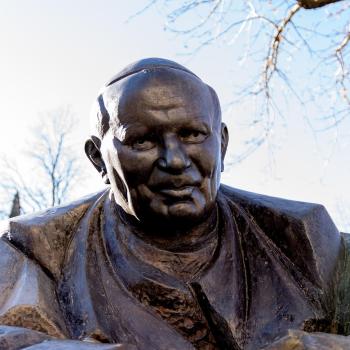PAUL’S QUESTION:
Can “evangelicals” and “charismatics” worship together?
THE RELIGION GUY’S ANSWER:
Ah, those “worship wars” that have so roiled and reshaped U.S. Protestant churches this past half-century. The questioner, a music teacher, has attended “evangelical” churches with relatively “traditional” worship compared with the “contemporary” style associated especially with “charismatic” churches.
“We’ve gone through a monumental shift of style in our lifetime, which has never happened before,” says Ed Stetzer of Wheaton College (Illinois). Music is only part of the ongoing, sweeping evolution toward popular, informal, and “seeker-friendly” worship but it’s right at the center.
Paul posted this some time ago. The Guy decided to address the topic when the New Yorker profiled the late singer-songwriter Larry Norman as the leading “Christian rock” pioneer in the late 1960s. (The writer, Kelefa Sanneh is the son of Lamin Sanneh, professor of world Christianity at Yale Divinity School.)
His article began with a clergyman’s 1958 column declaring traditional church music to be “totally incompatible” with rock. He insisted that “the profound sacred and spiritual meaning of the great music of the church must never be mixed with” rock, which “so often plunges men’s minds into degrading and immoral depths.”
So believed the Rev. Dr. Martin Luther King, Jr., shortly after he led the epochal Montgomery bus boycott. Countless preachers agreed with him during that early phase of rock ‘n roll.
Years later, the onset of Norman and others in the “Christian rock” subculture coincided with the youthful “Jesus movement” and the rise of new “charismatic” congregations that emphasized youth appeal and informal worship. Two churches in southern California, Calvary Chapel and The Vineyard, fostered hundreds of daughter congregations and produced widely-used songs.
The hard rock scene was built around concerts and records as many churches upheld King-style traditionalism. But gradually, softer rock, “adult contemporary” and other pop music genres infiltrated Sunday mornings at more congregations and, as Sanneh observed, “helped make traditional hymnals obsolete.”
The shift to “contemporary Christian music” (CCM) or “praise band” worship was especially useful in the “charismatic” movement, an exuberant and emotion-driven subset of U.S. evangelicalism similar to the earlier Pentecostalism, with its influential “megachurches.”
“The contemporary worship movement swept from its West Coast origins north and east, along with less formal style and California praise music backed by electric guitars and rock-style drums,” writes David Roozen of Hartford Seminary’s Faith Communities Today project.
By 2004, a national survey of Protestant pastors for Facts and Trends found 51 percent said their worship style had become more contemporary the past five years vs. 15 percent reporting a traditional move.
Roozen’s survey data covers all Christian congregations, not just evangelicals and charismatics. Since “worship style” is a vague term, Roozen employs regular use of electric guitars in worship as a good “contemporary” index. In 2000, 23.9 percent of congrregations featured guitars vs. 34.8 percent by 2015. Regarding informality, the 2005 survey found 37.9 percent used projection screens during worship compared with 52.9 percent by 2015.
Similar numbers come from Mark Chaves of Duke University’s National Congregations Study. Another barometer is church choirs that so bonded members as a perennial aspect of Protestantism. In 1998, 69 percent of large evangelical congregations had choirs but a mere 36 percent in 2012, while evangelicals as a whole saw a decline from 44 to 35 percent.
Other markers in Duke data: More drum kits, fewer pipe organs, fewer printed bulletins with an order of worship, more personal testimonies, more physical movement, more shouts and more applause breaking out during services. Many observe the decline of preachers’ conventional robes or dark suits, and informal attire for worshipers. Congregations may replace pews with theater seats, and some even fear to pass offering plates.
To Paul’s specific point, some churches remain all-traditional and others all-contemporary. Larger churches often provide multiple services with distinctly different styles, nearly becoming separate congregations. The other option is “blended” worship to incorporate elements of both tendencies.
Chaves reports that congregations with multiple services are moderating differences somewhat, and hypothesizes that “worship wars” are less intense. In 2006, 48 percent of congregations with multiple services reported important differences between them, compared with only 30 percent as of 2012. In 2012, 33 percent of big churches said informality remained as an important difference and 25 percent said music was different.
One challenge is keeping up with musical fashions. Church consultant Tony Morgan worries that as churches still work to accommodate rock and pop, only 4 percent in his survey used either hip-hop, rap, R and B, or soul, which claimed 32 percent of the top iTunes hits.
Leaders of churches that go contemporary tell interviewers this boosts attendance and vitality. With secularization reaching crisis proportions among young adults, any music that appeals seems worthwhile even if it uncouples current Christians from their sense of the prior 20 centuries. Evangelicals’ embrace of popular styles may be an important factor in their relative stability compared with decline among “mainline” Protestants that veer somewhat more traditional.
Critics complain that new choruses are repetitive and biblically and theologically thin compared with older Protestant hymns. While substance is simplified, the musical lines are more complex and tough to sing together, reflecting tropes of solo performance. Amplification and spotlights shift the focus to performers and can suppress worshipers’ shared participation in song.
A final sermonette: The Guy’s daughter, as a professional musician, emphasizes the importance of ear plugs and drums walled off behind plastic. Many Christian stage bands use such heavy amplification that it can damage worshipers’ hearing. For medical reasons, churches should avoid handicapping members and use the minimal volume necessary or, if feasible, going all-acoustic.












